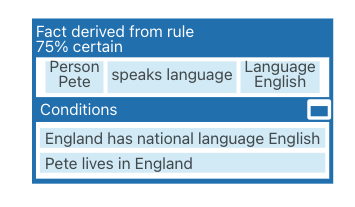The rationale behind a result that Rainbird has produced can be viewed by clicking the ‘i’ symbol next to the result. Clicking the ‘i’ symbol will take you to the evidence tree, which provides a visual representation of the rationale behind a result. The evidence tree will present you with a fact card detailing the conditions of the rule used to produce a result:

Figure 1: Evidence tree fact card
The rationale can be further interrogated by clicking the square symbol in the “Conditions” header to access the Salience View.
The Salience View is presented as a donut chart, and is a visual representation of the impact the weight of each condition in the rule had on the certainty of the fact the rule has produced.